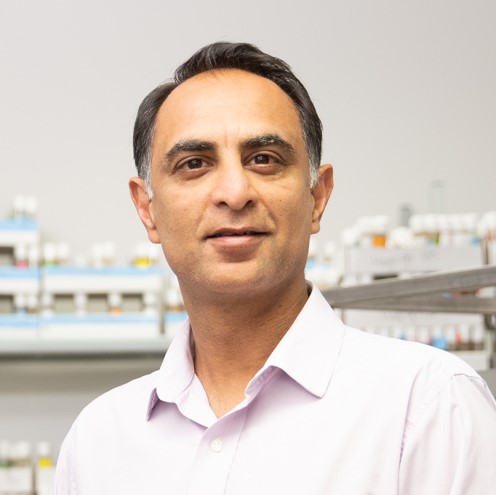by Buck Institute
May 8, 2024 . News
Hevolution Foundation funds promising pre-clinical studies at the Buck Institute
Aim: Moving discoveries from research on aging into the clinic
Recent awards totaling nearly $5M from the Hevolution Foundation will enable two Buck labs to further explore the biology of, and identify potential new uses for, two promising interventions for age-related diseases: ketone bodies and glycation-reducing compounds.


Buck Assistant Professor John Newman, MD, PhD, received more than $2.9 million; his project is aimed at understanding cell-specific aging mechanisms regulated by ketone bodies and their role in human longevity phenotypes. Buck Professor Pankaj Kapahi, PhD, received more than $1.9 million to investigate the connection between glycation and three hallmarks of aging, as well as exploring the potential of a glycation-reducing compound in mice.
Ketone bodies
Ketone bodies, naturally occurring compounds, are produced all the time by the body but increase when the availability of dietary carbohydrates (sugars in various forms) is limited, forcing the body to use fat instead of sugar for energy. Various forms of fasting and the popular high-fat, moderate-protein, and low-carbohydrate ketogenic diet can put people into ketosis, a metabolic state characterized by raised levels of ketone bodies in body tissues. Both fasting and the ketogenic diet have been linked to several health benefits, including weight loss, a reversal of metabolic syndrome and reduced inflammation.
“Ketone bodies are exciting in the aging field because they touch upon many of the hallmarks of aging, including reduced cellular energy, jumbled epigenetics, and chronic inflammation. While ketone bodies are being tested in clinical trials to treat heart failure and Alzheimer’s, mostly for their energy function, there’s still so much we don’t know about the biology,” said Newman, who is also a practicing geriatrician at UCSF and the San Francisco Veterans Affairs (VA) Medical Center. “We think of ketones as a niche, unusual thing. How often do we fast in modern life? But do our bodies actually need ketones as we age? How do ketone bodies impact specific cells like neurons in the brain? What other diseases of aging might benefit from treatment with ketone bodies? My team is very grateful for the Hevolution Foundation’s support for this important work.”
To ferret out more ketone biology Newman will be looking at how ketone bodies affect the mouse brain, building on earlier work that showed a ketogenic diet improved memory in aging mice. Newman says in the aging brain it’s unknown if neurons are the primary cell type that ketone bodies should be delivered to and where those ketones need to come from. “Most ketone bodies are made in the liver, but there are hints that some are made directly in the brain. This work will tell us where to focus to get the improvements we seek both in the brain and in overall health,” he said.
While Newman describes the mouse work as highly sophisticated – it will involve a deep dive into genetic modifications, phosphoproteomics, and mass spectrometry -he is particularly excited about a collaboration with UCSF that will mine data from the large, longitudinal UK Biobank that includes metabolomic information from hundreds of thousands of people. He says the proposed analysis could reveal a relationship between people who have higher or lower levels of ketone bodies in their blood with current and future disease states. “We know that people with heart failure produce more ketone bodies as a way of compensating for impaired energy metabolism,” he said. “What other conditions might be treated with ketone bodies? Are people with naturally higher ketone bodies resistant to certain diseases? This project allows us to ask those questions to help target future clinical trials for both treatment and prevention.”
Using glycation to understand how hallmarks of aging interact with each other
The Kapahi lab will use glycation, which occurs when sugar binds to proteins or lipid molecules, and its toxic methylglyoxal (MGO) byproduct to understand the interplay between three hallmarks of aging: dysregulated nutrient sensing, a loss of protein homeostasis and cellular senescence. In thanking Hevolution for their funding, Kapahi added, “It’s crucial that we understand the hierarchy of these detrimental processes. What comes first? Where should we target interventions? Glycation burden connects all three of these hallmarks giving us a unique opportunity to expand our understanding of age-related pathology.”
Kapahi’s team will investigate the connection between MGO-induced protein glycation, insulin resistance and cellular senescence in the context of type 2 diabetes. The first aim is focused on investigating the direct role of MGOs in regulating insulin synthesis and secretion. Pancreatic β-cells from mice will be used to mechanistically assess the cell-autonomous effect of different doses of GLYLO, a novel glycation-reducing compound on glucose metabolism and insulin synthesis. The second aim is directed at investigating the role of various dosages of dietary MGOs in regulating glucose homeostasis and insulin resistance in fat tissue, while validating targets that might ameliorate the resulting damage.
The team will bring the research together by investigating the interplay between MGO-induced protein glycation, insulin resistance and cellular senescence. “One hypothesis is that in overweight people type 2 diabetes is driven by inflammation caused by cellular senescence in belly fat,” said Kapahi. “Type 2 diabetes can also be driven in the pancreas. What’s the connection? Does senescence in the fat tissue also affect insulin secretion in the pancreas? What comes first?” Kapahi’s team will also test a senolytic drug to see if reducing the burden of senescent cells has an impact on MGO-mediated insulin resistance and release. They will also combine treatment with a senolytic and glycation-reducing GLYLO to determine if alleviating two hallmarks of aging, protein homeostasis and senescence, can show additional protection to lower insulin resistance and enhance survival in mice on a high fat diet.
DISCLOSURES: Dr. Newman owns stock in BHB Therapeutics, LTD, and Selah Therapeutics, LTD, which develops ketone body-based therapies and consumer products. The Buck Institute also has an ownership interest in BHB Therapeutics and Selah Therapeutics. Dr. Kapahi owns stock in Juvify Bio, the company that has commercialized GLYLO. He is also an inventor on patents that relate to the product being studied. The Buck Institute also has an ownership interest in Juvify Bio.
About the Hevolution Foundation:
Founded on the belief that every person has the right to live a longer, healthier life, Hevolution Foundation is a global catalyst, partner, and convener on a mission to drive efforts to extend healthy human lifespan and understand the processes of aging. With a focus on aging as a treatable process, Hevolution Foundation aims to increase the number of aging-related treatments on the market, compress the timeline of drug development, and increase accessibility to therapeutics that extend healthy lifespan, also known as healthspan. A global non-profit organization headquartered in Riyadh with a North American hub and an annual budget of up to $1 billion, Hevolution Foundation plans to open offices in other global locations to support a cutting-edge, global ecosystem of talent to propel aging and geroscience research forward and achieve medical breakthroughs to help humanity live healthier, longer. Connect with Hevolution Foundation on LinkedIn, X (formerly Twitter), and at hevolution.com
Science is showing that while chronological aging is inevitable, biological aging is malleable. There's a part of it that you can fight, and we are getting closer and closer to winning that fight.
Eric Verdin, MD, Buck Institute President and CEO